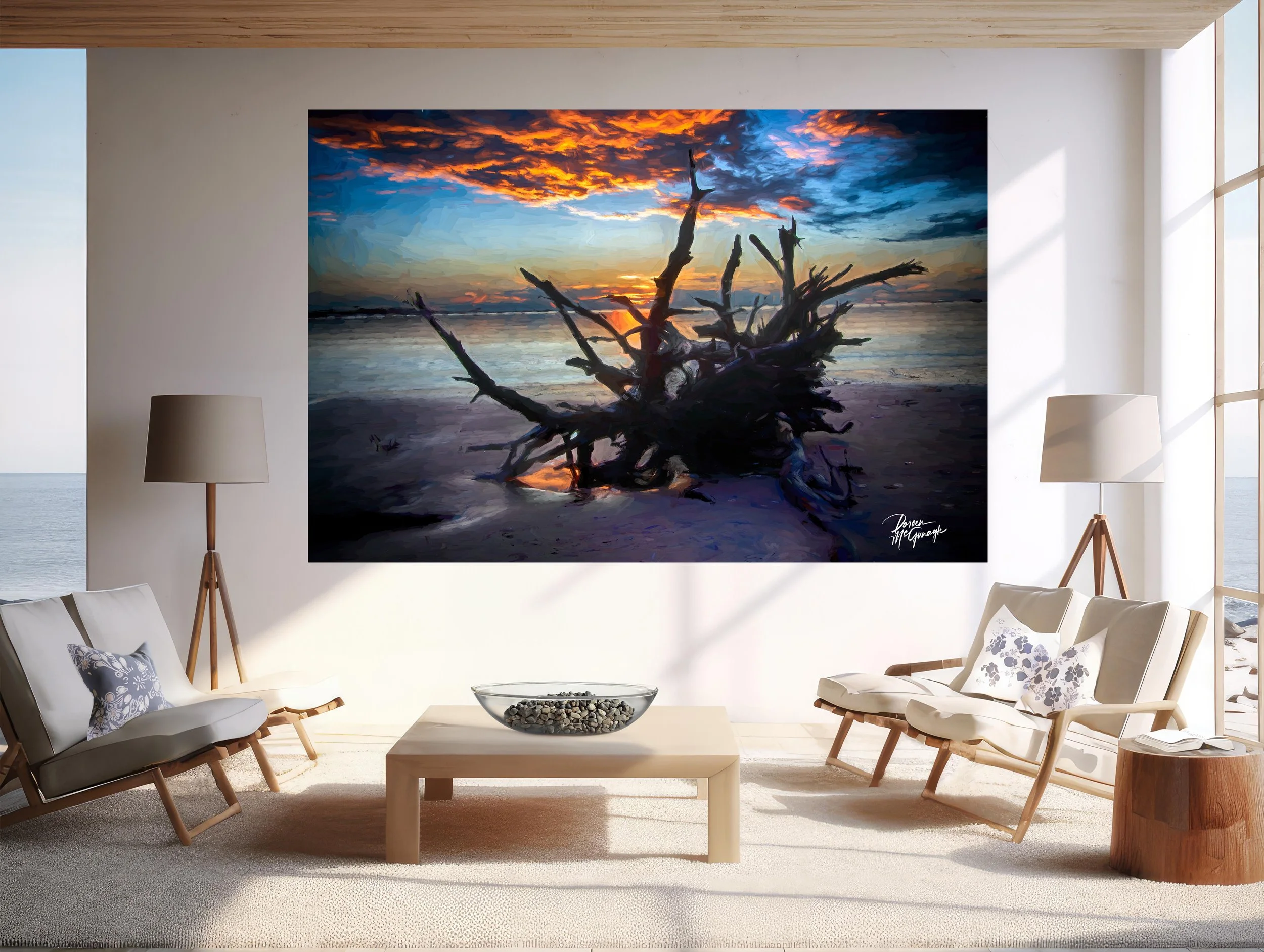Capturing the Beauty of Beaches
Capturing Coastal Beauty for Conservation: Doreen McGunagle's Fine Art Beach Photography
The beach is more than just a picturesque destination; it's a vital ecosystem teeming with life and complexity. Renowned fine art nature photographer Doreen McGunagle understands the intrinsic value of these coastal landscapes. Through her beach photography, Doreen aims to capture the natural beauty of these environments and raise awareness and support conservation efforts. This blog post delves into how Doreen McGunagle uses her fine art landscape photography to promote beach conservation, highlighting her techniques, inspirations, and the impact of her work.
Surreal Concert of Nature
Immerse yourself in the extraordinary beauty of a coastal sunrise with "Surreal Concert of Nature." This captivating piece commands attention with its dramatic composition and vibrant colors. Learn more
The Power of Beach Photography in Conservation
Beach photography can serve as a powerful tool for conservation by visually communicating the importance and fragility of coastal ecosystems. McGunagle's work captures the essence of the beach, showcasing its beauty while also emphasizing the need to protect it.
Key Elements in Doreen McGunagle's Conservation-Focused Beach Photography
Light and Timing:
McGunagle takes advantage of the golden hours—early morning and late afternoon—when the light is soft and warm. This time of day highlights the delicate textures and vibrant colors of the beach, creating captivating images that draw viewers in.
Sunrise and sunset shots often feature in her portfolio, offering stunning visual appeal while symbolizing the cyclical nature of tides and the ongoing need for environmental stewardship.
Composition:
Using the rule of thirds, McGunagle strategically places elements within the frame to create balanced, engaging compositions. This technique not only enhances the aesthetic appeal of her photos but also helps to guide the viewer's focus to critical aspects of the scene.
She often incorporates leading lines, such as the curvature of a wave or the edge of the shoreline, to draw the viewer’s eye through the image, reinforcing the interconnectedness of beach ecosystems.
Texture and Patterns:
McGunagle's keen eye for detail captures the intricate textures and patterns found on the beach. From the ripples in the sand to the foam of crashing waves, these elements add depth and interest to her photos, illustrating the complexity and diversity of coastal environments.
Highlighting natural patterns, such as the swirls left by receding waves or the delicate designs in shells and seaweed, McGunagle brings attention to the small wonders that are often overlooked but crucial to the ecosystem.
Weather and Atmosphere:
Weather conditions play a significant role in McGunagle's beach photography. Clear, sunny days provide vibrant colors and crisp images, ideal for highlighting the beauty of pristine beaches.
Overcast skies and stormy weather, on the other hand, create dramatic, moody scenes that emphasize the power and unpredictability of nature, serving as a reminder of the environmental challenges facing coastal regions.
Tips for Capturing Conservation-Focused Beach Photography
Plan Ahead:
Doreen emphasizes the importance of research and preparation. Understanding the location, weather patterns, and tide schedules can help photographers anticipate the best conditions for capturing compelling images.
Visiting the beach at different times of day and in various weather conditions provides a broader perspective on the environment, revealing both its beauty and its vulnerability.
Use the Right Equipment:
A sturdy tripod is essential for capturing sharp, detailed images, especially in low light conditions or when using long exposure techniques.
Wide-angle lenses are great for expansive scenes, while telephoto lenses can help isolate specific details, highlighting both the grandeur and the intricacies of the beach.
Protect Your Gear:
Beaches can be harsh environments for camera equipment. McGunagle recommends using weather-resistant covers and cleaning gear thoroughly after each shoot to prevent damage from sand, saltwater, and wind.
Lens filters, such as polarizers, can reduce glare and enhance colors, making them particularly useful for beach photography.
Experiment with Long Exposures:
Long exposures can create a dreamy, ethereal effect by smoothing out waves and capturing the movement of clouds. This technique requires a tripod and a slow shutter speed, often achieved with the help of neutral density filters.
Capture the Human Element:
Including people in beach photography can add a sense of scale and narrative. McGunagle often photographs local communities interacting with their environment, highlighting the relationship between humans and the coastal ecosystems they depend on.
The Art of Post-Processing
Post-processing is an integral part of Doreen's workflow, allowing her to enhance the natural beauty of her images and convey her conservation message more effectively. Doreen shoots in RAW to ensure that the final image's color and exposure are correct. Doreen often uses textures to create crisp and clear images highlighting coastal landscapes' intricate beauty.
Impact of Doreen McGunagle's Work
Through her stunning fine art beach photography, Doreen McGunagle raises awareness about the importance of conserving coastal environments. Her images capture the beauty of these landscapes and tell a story of resilience and the need for protection. She inspires others to appreciate and advocate for preserving these vital ecosystems by sharing her work with a broad audience.
In conclusion, beach photography is a powerful medium for promoting conservation. Doreen McGunagle's work exemplifies how art can foster a deeper understanding and appreciation of nature, ultimately encouraging efforts to protect and preserve our precious coastal environments. Through her lens, McGunagle captures the essence of the beach, turning each photo into a call for conservation and a testament to the enduring beauty of our natural world.
Explore our online gallery of limited-edition conservation fine art prints. Join us in celebrating and preserving the beauty of our natural world through our exquisite collection of fine art photography.

